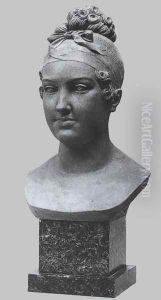Francois-Nicolas Delaistre Paintings
François-Nicolas Delaistre was a French sculptor born in 1746 in Paris, France. Emerging from a period that straddled the late Rococo style and the early neoclassicism, Delaistre's career was significantly shaped by the transformative events of the French Revolution and the ensuing Napoleonic era. His artistic journey mirrors the tumultuous shifts in French society and art during the late 18th and early 19th centuries.
Delaistre was initially trained under the tutelage of prominent sculptors of his time, which helped him develop a profound grasp of classical forms and the emerging neoclassical aesthetic. This foundation allowed him to adapt and thrive as the political and cultural landscape of France underwent radical changes. His works, primarily executed in marble, reveal a meticulous attention to detail and a deep reverence for classical antiquity, characteristics that aligned well with the neoclassical movement that sought to revive the art and ideals of ancient Greece and Rome.
Throughout his career, Delaistre received several commissions that reflected the changing tastes and ideologies of his era. Notably, his sculptures often graced public spaces and government buildings, embodying the new republic's values and the Napoleonic regime's grandeur. Despite the political upheavals, Delaistre managed to navigate the complexities of the art world, contributing significantly to the public and monumental art that defined the period.
Delaistre's legacy, while perhaps not as widely recognized as some of his contemporaries, such as Jacques-Louis David in painting or Jean-Antoine Houdon in sculpture, is nonetheless significant for its contribution to the neoclassical movement. His works continue to be studied for their technical mastery and their reflection of the ideological shifts of his time. François-Nicolas Delaistre passed away in 1832, leaving behind a body of work that encapsulates a pivotal era in French art and history.
